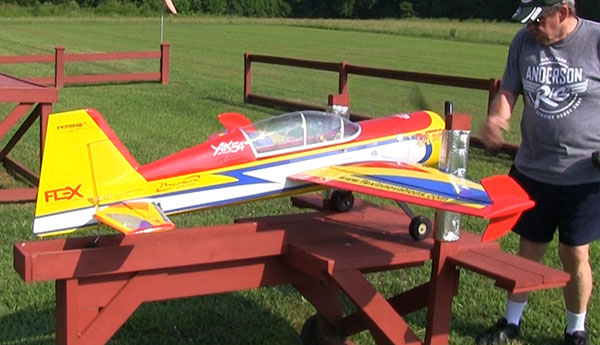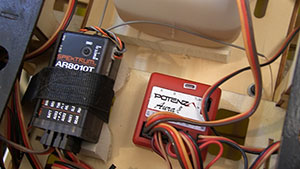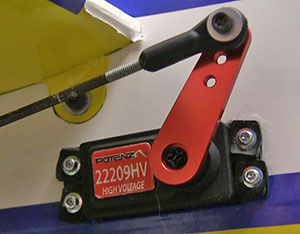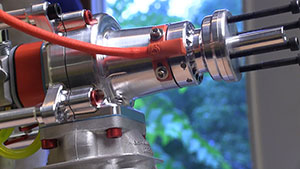



The Yak was no more difficult to assemble than other planes I have built.
Text, photos and video by Tom Hintz
Flight video by Clark Ponthier
Posted – 7-28-2017
Note: Let me say up front that I realize this review has been slow coming. The QQ YAK 54 35CC ARF (almost ready to fly) provided an ideal backdrop for a series of Reviews and How-To’s that in part fed the demand from FlyingRC.net viewers. Using one model for several stories made good fiscal sense for my independent web site, FlyingRC.net.
Assembly of the QQ YAK 54 35CC ARF was easier than most ARF’s I have built because of the thoughtful engineering, quality and high-end manufacturing. One of this is accidental but rather the result of in-house design and testing by what could be described as an over qualified cadre. The testing is done in large part by the same people doing the design. Factor in an instruction manual that breaks from the industry norm in that it really is instructive and you will find yourself with a ready-to-fly plane in less time than you might have thought.
Going over the covering is standard operating procedure for me with a new ARF model but on the QQ YAK 54 35CC ARF that turned out to be more for practice than need. I found one small portion of a covering edge that was not fully stuck down. It took way longer waiting for the trim tool to heat up than to fix the QQ YAK 54 35CC ARF covering.
The innovative, fiberglass/wood-laminated firewall comes drilled for the DA35 engine which made mounting it quick and easy. The engine even came with the proper-length stand offs for this model which eliminated that fitting and shimming.
The QQ YAK 54 35CC ARF airframe features a bolt-in floor section where the fuel tank and throttle servo are mounted. Using the stock location for the throttle servo made fabricating that linkage easy. I also used a manual choke rod which further simplified this straight-forward engine installation.

The Yak uses the Aura stabilization
system which uses up a bit more room
int he fuse.
I always use a remote engine kill system triggered by the “Trainer” button (momentary switch) to avoid accidentally shutting the engine down. To look at another system I went with the popular RCXL Opto Gas Engine Kill Switch. I have added a link to the manufacturers web page in the Resources section below. You can find these switches in many places so Google up the best source for you.
The RCXL Opto Gas Engine Kill Switch is really a compact optical switch that separates the ignition electronics from the receiver. There is a single lead coming out of the RCXL Opto Gas Engine Kill Switch that goes to a spare channel on your transmitter.
I put the RCXL Opto Gas Engine Kill Switch and its 2S, 7.4V 1300mAh battery on a switch with charging capabilities just to make it easier to charge the battery and to disable the engine when I am working on it.
We do have to glue the hinges in place but here again the process easier as well because of clean, precise manufacturing. Quality pin type (think Robart) hinges are included with the holes they go into pre-drilled at the factory. The holes are correctly sized and located so the control surfaces lined up properly during the first test fit. I almost felt like I was cheating the QQ YAK 54 35CC ARF by not spending enough time on the hinging but it was the factory prep that made this process easy and considerably faster than I am used to.
The QQ YAK 54 35CC ARF fiberglass control arms are designed to provide the best throw for this model. The slots in the control surfaces for the control arms were pre-cut and the covering over the slots removed cleanly at the factory. That just left applying epoxy to the slots and control arms and slipping them together.
I used the recommended aluminum servo arms also from Flex Innovations to produce the recommended throws at the control surfaces. The aluminum servo arms, by the way, are very well made with a cool red anodized finish. A little bling never hurt anyone, especially when it is tough enough to stand up to what wanna-be 3D pilots can do to planes in the sky. (I consider myself firmly in the 1-1/2D pilot range)
I should note that the aileron servo arms appear to be one-hole longer than needed. An instruction update on the Flex Innovations site says to connect the linkage to the second hole in from the end, 1-3/4” from the center of servo arm mounting screw. My linkage felt a little tight initially in this configuration but with a small drop of lube on the linkage balls that went away soon after moving the surfaces with servo power the first time.
Part of the package deal I bought from Flex Innovations were 6 of their Potenza DS22209 Digital High Voltage servos with titanium gears, coreless motors and an aluminum center section on the case. These servos produce 222 oz-in of torque and are used throughout the QQ YAK 54 35CC ARF.
I used the Potenza, house brand
servos and they worked well.
I am normally a devout HiTec servo fan but I was impressed with the
quality and thinking behind everything else I have seen from Flex Innovations so decided to go with their products nearly everywhere in this QQ YAK 54 35CC ARF project plane. On the bench, the Potenza DS22209 servos appear to be very quick. I would find they really are very quick when installed and connected to the control surfaces. Because the torque does not substantially exceed what is needed their current draw on the batteries will be lighter as well.
The lone exception to the included components came with my use of a Du-Bro 16oz gas tank. The tank that came with the QQ YAK 54 35CC ARF appears to be more than adequate for the job. Part of running a site like FlyingRC.net is trying to accommodate a wide range of product interests and preferences. Thousands of modelers, me included, have trusted Du-Bro products for well over 40 years so it is time for me to feature one of their products. Rest assured that if I had any doubts about using a Du-Bro tank in a brand-new plane I would have pushed that review back for a cheaper airframe.
After mounting the DA35 using the standoffs that came with it I began preparations to install the cowl. On the first “fit up” I noticed that with the cowl even with the forward cockpit former per the instructions, I had approximately a ½” gap between the front of the cowl and the back of the prop washer. I double checked the engine installation and found that the prop washer was spot of at 161mm, again per the instructions.
This ½” gap is not huge, just more than I normally try to get. Part of this gap is because the outer portion of a YAK cowl is forward of the “grille” work. I can’t see how the extra space between the back of the prop and the cowl will affect the flight of the QQ YAK 54 35CC ARF. However, I can imagine a substantial change in the CG if I were to move the engine, the heaviest part of the QQ YAK 54 35CC ARF, forward to close this gap. So, I am sticking with the specifications in the instructions.
The outboard leading edges sport “shark teeth” designed to stabilize maneuvers like Elevators and other high-angle flying. There is a slot already cut in the leading edge under the covering that accepts the plastic teeth sets. A word of caution when sanding the glue surfaces, the plastic “teeth” are painted so make sure you rough up only the glue area. I pushed both sets of teeth into their slots to be sure they fit and that shows how much of them will be in the glue area. The instruction suggests applying masking tape to the teeth to protect them from the epoxy. That works also but I toughed it out and wiped up the excess epoxy with alcohol on a paper towel. I’m a rebel.
The recommended DA35 provided more
than enough power.
The instructions note that the Sharks Teeth are optional but we know better. The QQ YAK 54 35CC ARF has the traditional clean lines to which the Sharks Teeth lend a bit of aggression. It can’t hurt for a plane this aerobatic to have some Sharks Teeth hanging out.
The QQ YAK 54 35CC ARF package I bought came with their Aura 8 flight control system. This is a gyro but not just another off-the-shelf, re-branded one. You will never hear me profess to understand how it does it but this little box really does smooth out the air so to speak while letting you fly the plane normally. What the Aura 8 Control System lacks is the annoying interference I have seen with other gyro-based systems when I use a bunch of rudder or slip a plane with cross control. The Aura 8 Control System works to stabilize the plane but does not fight your stick inputs. You really get to fly the plane while the Aura 8 works in the background to counter wind and turbulence. It does not shut the wind off altogether but it is close. For many people, the Aura 8 Control System literally makes more days flyable which makes it worth far more than the $99.99 (7-18-2017) it normally costs.
There is a free computer program available for download that lets you tweak virtually every setting within the Aura 8 Control System and many that we used to make in the transmitter. Rather than go into all that in this Review I will be producing a separate Review of the Aura 8 Control System soon.
While the Aura 8 Control System can be used with just a satellite receiver or two on smaller models I was not going to take a chance with my new QQ YAK 54 35CC ARF so installed a Spektrum AR8010T 8 channel receiver that has SRXL, a single male-to-male servo cable connecting it to the Aura 8 Control System. That alone made installation of the radio system easier and the ball of wires we normally wind up with a bunch smaller.
Though I bought the Spektrum AR8010T primarily for the SRXL capability it also features built-in telemetry including receiver battery voltage that requires no additional sensors. Using the light 1300mAh packs makes this adjustable low voltage warning capability reassuring.
The folks at Flex Innovations put out a list of components they have used in the QQ YAK 54 35CC ARF so we followed that. I am using the 2S, 7.4V 1300mAh LiPo packs, two (redundancy) for the radio/servos and one for the ignition. They include a deck that can be installed at the lower rear of the cockpit area for mounting the batteries if need be to get the CG right. Once again, they were dead on the money. I tried balancing in a few other configurations but it always came out a bit nose-heavy. However, when I put that extra deck in and set the packs there the balance came out perfect.
Though listed at 12lb 9oz my QQ YAK 54 35CC ARF came out right at 13lbs all up including 10oz or so of fuel. I did use the optional carbon fiber landing gear, the 1300mAh packs and a carbon fiber prop but this is still remarkably light for a plane this size.
Throughout building the QQ YAK 54 35CC ARF I kept finding things that indicated the folks at Flex Innovations did all their homework when designing this plane. Though all of the Flex Innovations are fresh, in-house designs, the fit and finish as well as the robust but light structure reminds me of the AeroWorks airframes so many of us loved.
Another surprise for me came when I looked at the price of the QQ YAK 54 35CC ARF. The ARF itself sells for $399.99 (listed as a sale price 7-28-2017) which is a real bargain in today’s RC marketplace. The package I bought that includes the DA35, Dessert Aircraft wrap-around Pitts-style muffler, the Potenza DS22209 servos, aluminum servo arms and the Aura 8 Control System for $1349.99 (7-28-2017), again, a great bargain.
If you are looking for a 35cc-type airplane with a long list of aerobatic capabilities you need to take a long hard look at the QQ YAK 54 35CC ARF and other planes from Flex Innovations. I think these folks will quickly become a major player in the ARF world. You have the chance to get in on that right now.
Visit the QQ YAK 54 35CC ARF product page – Click Here
Flex Innovations Aura 8 Video List
RCXL Opto Gas Engine Kill Switch
Have a comment on this Review? –Email Me!